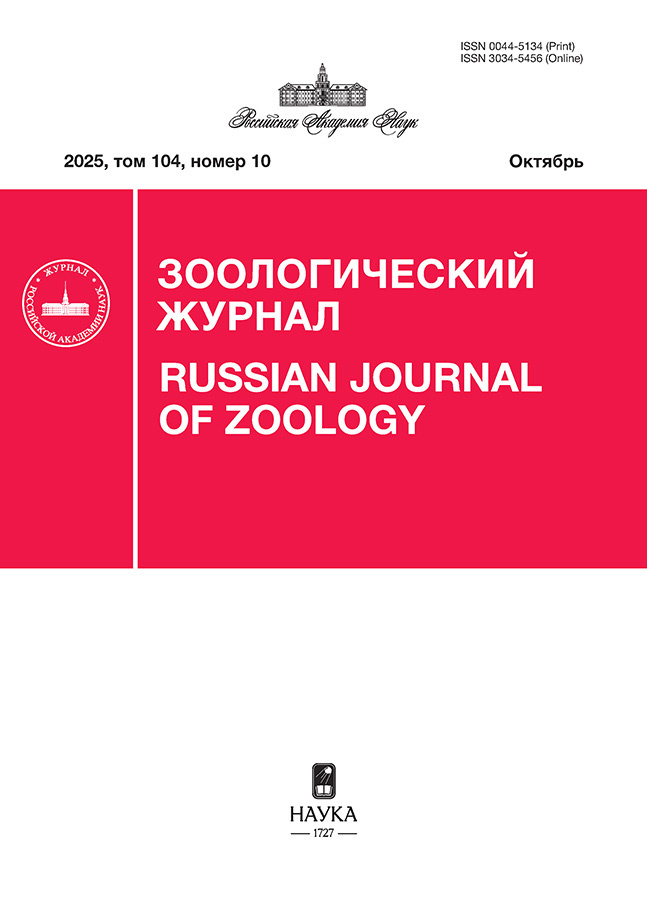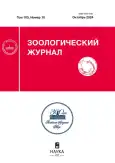Vol 103, No 10 (2024)
ARTICLES
New species and new records of oribatid mites (Acari, Oribatida) from Villa Clara, Cuba
Abstract
The present study is based on the oribatid mite material collected from the Villa Clara Province, Cuba. A list of 17 species, belonging to 11 genera and nine families, is presented; of them, one genus and three species are reported from Cuba for the first time. Two new species – Muliercula ornamenta Ermilov sp. n. (Scheloribatidae) and Galumna (Galumna) villaclaraensis Ermilov sp. n. (Galumnidae) – are described from soil litter with decaying leaves.
 3-11
3-11


Moraria (Baikalomoraria) okunevae sp. n. and Moraria (Baikalomoraria) ornofurcata sp. n. (Copepoda, Harpacticoida, Canthocamptidae) from Lake Baikal
Abstract
During the study of coastal harpacticoid communities of Lake Baikal, representatives of two new species were discovered: Moraria (Baikalomoraria) okunevae sp. n. and Moraria (Baikalomoraria) ornofurcata sp. n. Morphologically, both new species are similar to Moraria (Baikalomoraria) spinulosa Borutzky et Okuneva 1972, but differ well in the structure of the caudal rami. The morphology of these species was studied using scanning electron microscopy. An illustrated description is provided, and variability characterized.
 12-29
12-29


The female reproductive system of the genus Hololepta (Coleoptera, Histeridae, Histerinae, Hololeptini) and its significance for the systematics of the group
Abstract
Most species of the genus Hololepta show flat bodies and atypical ovipositor structures, these latter being adapted to laying the eggs inside wood. Cladistic analyses based on 33 characters of the adult insect body and 15 characters of the ovipositor support the monophyly of the genus. The subgenus Hololepta has more apomorphic characters than does Leionota. This study did not reveal any characters that show the monophyly of Leionota. In most species of the subgenus Hololepta the gonocoxites bear teeth that help pushing out the substrate during oviposition. The valvifers in most Hololepta species have longitudinal thickenings to further increase their strength. Our data show that the characters of the ovipositor are lower in value for phylogenetic reconstructions. The reproductive system of female Hololepta is more prone to convergences and parallelisms compared to the features of their external structure.
 30-54
30-54


Cold hardiness and overwintering conditions of larvae of the Siberian moth, Dendrolimus sibiricus (Lepidoptera, Lasiocampidae) from Central Yakutia’s population
Abstract
The Siberian moth, Dendrolimus sibiricus Tschetverikov 1908, is a dangerous pest of the conifer family Pinaceae that inhabits the Asian part of Russia, northern Kazakhstan, Mongolia, China and the Korean Peninsula. Its range is gradually expanding both westwards and northwards: the species is currently recorded at 46°–47° E over the Eastern European Plain, around 60° N in the Krasnoyarsk Krai and at 63° N in the Republic of Sakha (Yakutia). A number of studies have been devoted to predicting further dispersal of D. sibiricus, but the assessment of the pest’s invasion potential is hampered, among other things, by insufficient information on the requirements of the overwintering stage (larvae) to winter conditions. We evaluated the main features of pest biology, determined the cold hardiness of its larvae, and revealed the temperature conditions in the wintering places at the northeastern limit of its distribution in Central Yakutia. The average supercooling point of larvae was –18.5 ± 0.4°C, being significantly different (p ≤ 0.05) between individuals of younger (II–III and III–IV) and older (IV–IV) instars: –20.0 ± 0.6 and –18.8 ± 0.8°C, vs –16.7 ± 0.8°C, respectively. A prolonged (2 days) stay at –15.5°C leads to death of 53% individuals, 63% mortality at –17.5°C and already 91% at –20°C. Comparing larval cold hardiness and the temperatures in hibernation horizons in one of the coldest regions within the natural range of the pest shows suitability of large areas of Yakutia for D. sibiricus survival, especially currently due to climate warming.
 55-71
55-71


The Hawksbill Turtle (Eretmochelys imbricata) in the Russian Far East and other new sea turtle records
Abstract
Between 2018 and 2023, four new records of sea turtles (Dermochelyidae, Cheloniidae) belonging to three species (Dermochelys coriacea, Chelonia mydas and Eretmochelys imbricata) were recorded in Russian Far Eastern waters. The Hawksbill Turtle (E. imbricata) is reported from Russia for the first time. This adult female was caught by fishermen in the strait between Kunashir and Shikotan islands. An adult specimen of D. coriacea was captured in nets in the Kunashir Strait of the Sea of Okhotsk near the village of Tretyakovo. Several skeleton fragments of Ch. mydas were found near the Alyokhin Cape of Kunashir Island. The Green Turtle, Ch. mydas, is recorded from the Kuril Islands for the first time, very likely that specimen belongs to the Pacific subspecies, the Black Turtle (Ch. m. agassizii). Another species of sea turtle, the Olive Ridley (Lepidochelys olivacea), is also likely to occur in the southern part of the Far Eastern sea area. The Leatherback Turtle, D. coriacea, is the only species regularly entering Russia’s waters and has been recorded at least two dozen times in the Sea of Japan, the Sea of Okhotsk, and the Bering Sea, and in the Pacific waters of the Russian economic zone near the southern Kuril Islands. Two other species, the Loggerhead, Caretta caretta, and the Green Turtle, Ch. mydas, have been recorded only a few times. The actual number of sea turtles entering Russia’s waters is higher than the number given in official sources. A tendency for sea turtle records to increase in the temperate and subarctic zones seems to be associated with increased fishing in the region. Bycatch study in temperate and subarctic zones may provide new information on the distribution and biology of sea turtles in the north and also allow for methods for reducing accidental turtle mortality to be developed.
 72-79
72-79


A case of partner change in a pair during the nesting period in the white stork (Ciconia ciconia L. 1758, Ciconiiformes, Ciconiidae) and its consequences
Abstract
The nesting behavior of white storks, Ciconia ciconia, when one of the partners in a pair deserted, is described. This case was observed in the summer of 2023 in a nest located in the village of Shestikhino, Nekouzsky District, Yaroslavl Region. The behavior of storks on the nest was recorded around the clock using an online camera. Around the middle of the season, the male of the pair was injured and left the nest. Eight days later, a stranger male stork began to appear on the nest. The behaviors of the stranger, the female, the resident male and the chicks are described.
 80-87
80-87


Perspectives of Amur tiger (Panthera tigris altaica) conservation, a population in the Khabarovsk Krai taken as an example
Abstract
The study is aimed at assessing the status of the key Amur tiger population, Panthera tigris, in the Khabarovsk Krai in the conditions of sharply deteriorated trophic conditions caused by the African swine fever outbreak and ongoing habitat degradation. Two relatively large areas where typical regional economic activities are conducted were chosen as study sites. The research was conducted using both traditional (snow tracking) and modern (camera traps) methods, which, in combination, helped reduce subjectivity in interpreting the results. An analysis of critically important factors negatively impacting the tiger population at the northern limit of their distribution was performed. Excessive tiger mortality in recent years has been demonstrated, which could lead to long-term negative processes in the population and significant reduction. Possible measures to reduce the emerging threats to the northernmost Amur tiger population (Panthera tigris altaica) are discussed.
 88-106
88-106


Cortisol concentration in hair of the Baikal seal (Pusa sibirica Gmelin 1788, Carnivora, Phocidae): the effects of sex, age, and the dynamics of ice destruction
Abstract
Measuring hair cortisol concentrations is a widespread method of hormonal research in natural populations. In particular, it has increasingly been used for assessing the chronic physiological stress over long time periods. This study showed for the first time the experience of using hair of Baikal seals to examine their hormonal status. We collected hair samples from live Baikal seals captured during summer expeditions to the Ushkany Islands, Lake Baikal in 2019 and 2021. Age differences in hair cortisol concentration were found: hair cortisol levels were higher among the young seals and declined with age. We suppose this may be related to different extents of nutritional stress, hunting success and social factors on summer rookeries. There was no sex effect on hair cortisol in young animals. We observed that hair cortisol concentrations were higher in young animals captured in 2019 compared to seals taken in 2021, with no differences in ice conditions between these years found.
 107-115
107-115


Obituary
Vladislav Vilgelmovich Khlebovich (27.02.1932–22.02.2024)
 116-124
116-124










